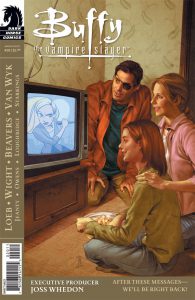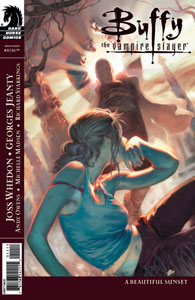My reviews looking back at “Buffy” Season 8 continue. SPOILER WARNING: If you are reading these issues for the first time, I will analyze the character of Twilight based on my knowledge of Twilight’s true identity, which isn’t revealed until later in the season.
“A Beautiful Sunset” (Issue 11, February 2008)
This Joss Whedon issue is a prologue for “Wolves at the Gate,” and a reverse of “Conversations with Dead People” (7.7). In that fan-favorite episode, Buffy is psychoanalyzed by the vampire Holden. Here, Buffy is thrust into the older mentor role amid a graveyard battle, as she (with impressive maturity) romantically rejects Satsu – having figured out Satsu loves her because of the cinnamon lip gloss and other evidence — while also building her up. (However, this ain’t the end of Buffy-Satsu; see the next arc.)
Then Twilight – talking to his demon underlings – psychoanalyzes Buffy. While Buffy is gaining some confidence in interpersonal relations, she has never lacked conviction that she’s on the right side of the good-vs.-evil conflict. Twilight’s goal is to destroy that conviction. And also to wipe out the existence of magic (which I’m kind of on board with, as these comics get increasingly magicky). In a classic Whedon moment, Twilight appears to be pulling his mask off to talk to his hench-demons, but he’s merely scratching his chin.
Later in Season 8, we’ll learn that Twilight is Angel, so on this re-read I ask myself “Does this seem like something Angel would do?” For now: Not at all. Admittedly, I am due for a re-read of “Angel: After the Fall,” which takes place before “Buffy” Season 8, although if memory serves, that series doesn’t contain a lot of clues pointing to Angel’s interest in a grand plan to knock Buffy off her power perch.
3.5 stars

“Wolves at the Gate” (Issues 12-15, March-June 2008)
Drew Goddard made a splash on “Buffy” Season 7 and “Angel” Season 5, and smoothly delivers his first major comic arc here after two “Tales of the Vampires” shorts. Unfortunately, this marks the end of his Buffyverse comic writing, as he quickly became a big-name Hollywood writer and director (“Bad Times at the El Royale” is his latest film), but it’s certainly a memorable entry.
Honestly, the biggest strength of “Wolves at the Gate” is the stuff with Dracula, Renee and Xander – who is getting his best characterization since Season 3. I’m not a huge Dracula fan, but when he’s written this well, I appreciate it. The Dark Prince is down in the dumps, but he teams up with the Slayer Organization to take out Japanese vampires who have stolen his morphing powers, and in a nice moment, he allows Xander to finish off the vamp who killed Renee. I have to admit I was surprised when Renee gets killed in battle. “Buffy” hasn’t lost its knack for shocking deaths, and I really feel for Xander after his cute chats with Renee about their first-date plans.

But “Wolves at the Gate” is infamous for Buffy having sex with Satsu in Issue 12. It bothered me at the time because I felt that if Buffy had bisexual tendencies, they should’ve been peppered into the narrative before this. (I had a similar problem with Willow’s shift in sexual orientation on the TV series, although in that case it irks me that she is labeled as gay when the evidence shows she is bisexual.)
Some fans also wondered — and worried — if the foundation for a Willow-Buffy hookup was being laid, and if “Buffy” was going to become a big ole gay romp. (Not that there’s anything wrong with that. It’s fine if that’s who you are. But there would be a risk that other “Buffy” themes would be subsumed by a hot-button political issue. Even setting aside sexual orientation, Season 8 is already preoccupied with romantic relationships, as they are central to the arcs of Buffy, Willow, Xander and Dawn at this point.)
On this reading, Buffy-and-Satsu doesn’t bother me at all, probably because enough time has passed. I can appreciate Goddard’s and artist Georges Jeanty’s brilliant comic timing as one person after another walks in on the pair. Plus, while Buffy having sex with a woman seems to come out of nowhere, it’s not treated as a joke, as Buffy and Satsu converse about what it means for both of them. It’s a cliché, but Buffy is indeed experimenting, and Goddard aims to portray this accurately.
In retrospect, if there’s anything controversial about “Wolves at the Gate” it should be that the bad guys have constructed a Mecha-Dawn to take on Giant Dawn as she stomps through the streets of Tokyo. But I can’t deny that Dawn saying “Roar” amid fleeing vampires made me smile. The Mecha-Dawn is perhaps a step too far, but what the heck; the overall tale builds up enough credit that I’ll let Goddard have it.
4.5 stars

“Time of Your Life” (Issues 16-19, July-November 2008)
Although we never got a “Fray II,” “Time of Your Life” is the next best thing. Actually, it’s better, because we get two of our favorite Slayers: Buffy goes 200 years into the future and crosses paths with Melaka Fray. Karl Moline is appropriately back, as having someone else draw Fray would be like having another actor play Angel, and he also draws an awesome Buffy, even if she is wearing an impractical frock.
Whedon again brings his A-game to this Fray story. While the world-building was done in the 2001-03 eight-issue series, there are some new things to learn here; for example, Haddyn comes from “Manhattan” – of course! Mostly, it’s a blast to see Buffy react to this world, particularly to how the English (or rather ’Merican) language has evolved (or devolved, as it were).
Buffy (ticking off items on her fingers): “Vampires are lurks. A spin is a lie. Toy is bad. Spled is good. Boy, the English language is just losing it. I should have treated it better …”
And later:
Fray (coincidentally quoting Principal Snyder): “Summers, you drive like a spaz!”
Buffy: “And that phrase stood the test of time?”
Unlike “Fray,” “Time of Your Life” isn’t a self-contained story; it’s part of the wider serial and a lot of things go unexplained for now. This whole encounter is arranged by Future Willow, who like Dana Scully in “The X-Files,” apparently lives forever. The future version looks like Season 6’s Wicked Willow, but also sad and resigned. Like Twilight/Angel, she seems to be maneuvering pieces on a global (and temporal, in this case) chess board. We don’t learn why Future Willow engineers these events, but it’s still powerful when Buffy – who is forced to kill Future Willow — returns through the portal and immediately hugs Willow and tells her she loves her.
I’m not on board with Centaur Dawn like I was with Giant Dawn, and the castle in Scotland being surrounded by what is essentially “Harry Potter’s” Forbidden Forest, complete with talking tree creatures, moves Season 8 further into too-much-magical-stuff territory. Whenever we cut back to the present-day action, it’s a reminder of how vibrant and creative Fray’s era is by comparison.
4.5 stars

“After These Messages … We’ll Be Right Back!” (Issue 20, December 2008)
Between 2001 and 2004, “Buffy: The Animated Series” got as far as a short presentation pilot and a half-dozen scripts, then it simply never happened because no network wanted it. It fell through the cracks by being too adult, too kiddie and too expensive, depending on a networks’ perspective. (Come to think of it, with all the streaming outlets today, it’s surprising the concept hasn’t been resurrected.)
The light and humorous “After These Messages …” is an ode to that DOA series, written by animation legend Jeph Loeb, who would’ve produced the show. In a yarn that features art by Eric Wight, Ethen Beavers and Adam Van Wyk in the “Animated Series” style, Buffy dreams she is in a Season 1 adventure. She is back in her sophomore-year body with her friends, her mom and her sister in this simpler time.
It speaks to the power of rose-colored nostalgia that Buffy is so happy, but if you watch Season 1, that’s not the word that would come to mind to describe her. Yet she’s also glad when the dream ends and she sees her friends and Dawn in their present-day form. The human mind and memories are funny things, and “After These Messages …” captures that wonderfully. (For short prose story in this vein, check out Jane Espenson’s “Again,” from “Tales of the Slayer, Vol. 2.”)
4.5 stars

